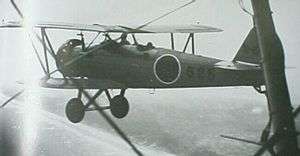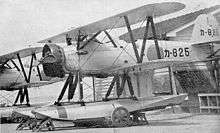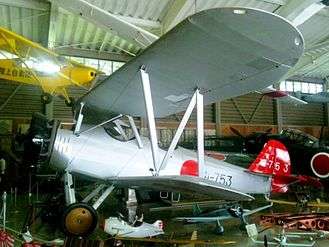Yokosuka K5Y
| K5Y | |
|---|---|
 | |
| K5Y1 | |
| Role | Intermediate trainer |
| Manufacturer | Various, see text |
| First flight | 1933 |
| Introduction | 1934 |
| Primary user | Imperial Japanese Navy Air Service |
| Produced | 1934-1945 |
| Number built | 5,770 |
The 九三式中間練習機 (Yokosuka K5Y kuusanshikichuukanrenshuuki) was a two-seat unequal-span biplane trainer (Allied reporting name: "Willow") that served in the Imperial Japanese Navy during World War II. Due to its bright orange paint scheme (applied to all Japanese military trainers for visibility), it earned the nickname "aka-tombo", or "red dragonfly", after a type of insect common throughout Japan.
A K5Y of the Kamikaze Special Attack Corps 3rd Ryuko Squadron was credited with sinking the destroyer USS Callaghan on July 29, 1945, the last US warship lost to kamikaze attack during the war.
Design and development
The aircraft was based on the Yokosuka Navy Type 91 Intermediate Trainer, but stability problems led to a redesign by Kawanishi in 1933. It entered service in 1934 as Navy Type 93 Intermediate Trainer K5Y1 with fixed tail-skid landing gear, and remained in use throughout the war. Floatplane types K5Y2 and K5Y3 were also produced. After the initial 60 examples by Kawanishi, production was continued by Watanabe (556 aircraft built), Mitsubishi (60), Hitachi (1,393), First Naval Air Technical Arsenal (75), Nakajima (24), Nippon (2,733), and Fuji (896), for a total of 5,770. These aircraft were the mainstay of Imperial Japanese Navy Air Service's flight training, and as intermediate trainers, they were capable of performing demanding aerobatic maneuvers. Two further land-based versions, the K5Y4 with a 358 kW (480 hp) Amakaze 21A engine and the K5Y5 with a 384 kW (515 hp) Amakaze 15, were projected but never built.[1]
Variants

- K5Y1
- Two-seat intermediate trainer for the Imperial Japanese Navy.
- K5Y2
- Floatplane version, with Amakaze 11 engine.
- K5Y3
- Floatplane, with 384 kW (515 hp) Amakaze 21.
- K5Y4
- Projected land-based version with 358 kW (480 hp) Amakaze 21A. Never built.
- K5Y5
- Projected land-based version with 384 kW (515 hp) Amakaze 15. Never built.
Operators
Postwar

- Indonesian People's Security Force (the precursor of Indonesian Air Force) operated derelict aircraft against Dutch colonial rule. On July 29 1947, Indonesia using 2 units of Yokosuka K5Y (Called "Cureng/Churen" by Indonesian fighters) with one "Guntei Bomber" (Mitsubishi Ki-51 from Maguwo Air Force Base, Yogyakarta for bombing Dutch strategic positions in Ambarawa, Salatiga and Semarang. On its original plan, Nakajima Ki-43 "Hayabusa" also planned to be involved too in this operation, but cancelled as the aircraft suffered technical difficulties. It is currently on display at Jakarta.
Specifications (K5Y1)
Data from Japanese Aircraft of the Pacific War[2]
General characteristics
- Crew: Two
- Length: 8.05 m (26 ft 5 in)
- Wingspan: 11.00 m (36 ft 1 in)
- Height: 3.20 m (10 ft 6 in)
- Wing area: 27.7 m² (298.2 ft²)
- Empty weight: 1,000 kg (2,205 lb)
- Max. takeoff weight: 1,500 kg (3,307 lb)
- Powerplant: 1 × Hitachi Amakaze 11 nine-cylinder air-cooled radial engine, 224 kW (300 hp)
Performance
- Maximum speed: 212 km/h (115 knots, 132 mph)
- Cruise speed: 138 km/h (75 knots, 86 mph)
- Range: 1,019 km (550 nmi, 633 mi)
- Service ceiling: 5,700 m (18,700 ft)
- Climb to 3,000 m (9,845 ft): 13 min 32 sec
Armament
- Guns: 1× fixed, forward-firing 7.7 mm (.303 in) Type 97 aircraft machine gun and 1× flexible, rearward-firing 7.7 mm (.303 in) Type 92 machine gun
- Bombs: Up to 100 kg (220 lb) of bombs on external racks
See also
Aircraft of comparable role, configuration and era
References
- Notes
- ↑ Francillon 1979, p. 446.
- ↑ Francillon 1979, p. 448.
- Bibliography
- Collier, Basil. Japanese Aircraft of World War II. London: Sidgwick & Jackson, 1979. ISBN 0-283-98399-X.
- Francillon, R.J. Japanese Aircraft of the Pacific War. London: Putnam & Company Ltd., 1970 (2nd edition 1979). ISBN 0-370-30251-6.
- Mondey, David. The Concise Guide to Axis Aircraft of World War II. London: Chancellor Press, 1996. ISBN 1-85152-966-7.
- Tagaya, Osamu. Imperial Japanese Naval Aviator, 1937-45. Botley, Oxfordshire, UK: Osprey Publishing, 2003. ISBN 1-84176-385-3.
External links
| Wikimedia Commons has media related to Yokosuka K5Y. |